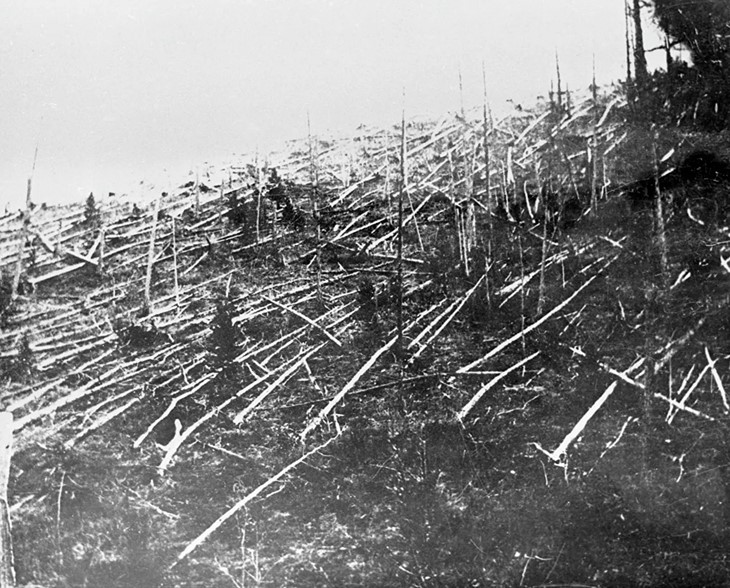
I learned this today. The Tunguska event was probably a meteor air burst that exploded over Eastern Siberia on June 30th, 1908.
Today, as of writing, it is the 114th anniversary of the Tunguska event. Early in the morning of Tuesday, June 30th, 1908, there was a bluish light almost as bright as the sun, moving across the sky. There was a flash, a pillar of fire, and a cloud of smoke. Ten minutes later, witnesses heard the sound of what they described as artillery fire. There was a shock wave that knocked people off their feet and broke windows hundreds of kilometers away.
The explosion knocked over 80 million trees, throughout an area of 2,150 km2, which is three times larger than the city of New York. Three people possibly died in the explosion, but the deaths were only reported by eye witnesses and there is no proof. The fact that it happened in an incredibly isolated and sparsely populated part of Siberia probably saved a huge number of deaths. If it had happened in a major city, who knows how many could have died.
So, what caused it? There seem to be four main theories. One of them has absolutely no evidence, so let’s get that out of the way first.
The first theory is aliens. This theory cropped up because there is no impact crater. A meteor large enough to cause an explosion like Tunguska should have left a sizeable impact cater, but none has been found. On top of this, crystals and minerals that did not match the surrounding area were found. That, coupled with the fact that the Soviet government didn’t allow researchers to enter the area for ten years, has given rise to theories of aliens. There are so many more reasons against this idea than there are for it that it is not worth discussing further.
The remaining three theories are a meteor impact, a glancing impact, or an asteroid impact.
A meteor strike is probably the most likely cause. Looking at the blast radius, the explosion was probably the equivalent of up to 30 megatons of TNT. For comparison, the atomic bomb dropped on Hiroshima was 15,000 tons of TNT. Calculations show that the meteor was probably a stony meteoroid and was probably about 60m across. It would have entered Earth’s atmosphere travelling at about 11m/s. Because of the mass of the meteoroid and the speed it was travelling, it would have compressed all of the air in front of it, building up incredible heat and pressure. This is called ram pressure. The heat and pressure would have built to such an extent that the meteoroid would have exploded at about 6 to 10 km above the surface of the Earth.
Evidence for this theory comes from the nickel found in the soil and the silicate and magnetite spheres that were found. Iridium was also found in the ground. All of these elements are common on meteors and they were found in higher concentrations in the impact zone than around it.
The main problem raised with this theory is that a meteoroid of this size should have left an impact crater. It is possible that the explosion ripped the entire meteoroid to pieces and scattered it through the atmosphere, but it is thought to be a little unlikely.
The third theory is the glancing impact hypothesis. As the name of the theory suggests, a rocky asteroid of 200 meters, travelling at 11.2 km/s, could have bounced off Earth’s atmosphere and headed back out to space if its trajectory was oblique enough. This could have caused an explosion and wouldn’t have left an impact crater.
The final theory is the comet impact theory. Comets are mainly made of dust and ice so any comet impacting with Earth’s atmosphere would completely disintegrate before it reached the ground. Computer modeling done in 2008 showed that the comet would produce a shockwave that explains the damage on the ground and all of the comet’s matter would be dispersed through the atmosphere. The problem with this theory is that it doesn’t explain the nickel and other elements found on the ground and a comet would have disintegrated long before it reached 10 km above the ground.
As nobody was there, it is very difficult to know what happened. However, a recent discovery seems to be opening the debate again.
Lake Cheko, is a small bowl shaped lake that is 8 km away from the center of the Tunguska blast. At first, judging from the silt at the bottom of the lake, it was thought to be 5,000 years old. However, recently, scientists analyzed the sediments, isotopes, and pollen and they decided that the lake was only 100 years old. They also found that the lake bed was conical in shape, which would be consistent with an impact crater and magnetic readings found a possible meter-sized rock at the lake’s deepest point. Could that be the impact crater for the meteor? A lot of other scientists dispute this, so I don’t know. Will we ever know?
Meteor strikes are very common. About 17 tiny meteors hit Earth almost every day. Meteors the size of the Tunguska one probably hit Earth every few hundred years. Asteroids of 1 km hit Earth every 500,000 years. Objects over 5 km hit Earth every twenty million years. The dinosaur killing asteroid was about 10 km across. And this is what I learned today.
Photo By Soviet Academy of Science – https://commons.wikimedia.org/w/index.php?curid=116482846
Sources:
https://en.wikipedia.org/wiki/Tunguska_event
https://en.wikipedia.org/wiki/Lake_Cheko
https://www.britannica.com/story/what-is-known-and-not-known-about-the-tunguska-event
